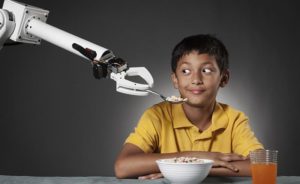Green Revolution. Can Artificial Intelligence Feed The World?
AI • Jul 31,2016

Green Revolution. Can Artificial Intelligence Feed The World?

The Earth isn’t getting any bigger and the world’s population only grow, so we need to start finding more efficient ways to feed the projected 10 billion people by 2050 using the same amount of land. This will require a 70% increase in food production. Domination of the agricultural complex in the 21st century will require two things: biological data sets and engineering talent to apply AI to them. Artificial intelligence is a perfect technology that can be used to tackle this challenge.
Already, advances in automation and robotics are making the global food manufacturing and processing industries more efficient, productive and safer. But, the supply chain has to become smarter and even more innovative than it is now if it is to deliver higher quality and quantities of food in the future.
Being able to analyse the images of satellites to study climate shows us the impact of broad changes in precipitation patterns. Our models of weather are getting better and better, allowing now amazingly precise predictions within a day. Data analysis in genetics or in the development of better tools for pest control allows increased yields at lower levels of pesticides. Integrating sensor data in a feedback loop with control systems makes autonomous drones possible for the monitoring of crops.
Researchers from EPFL in Switzerland and Penn State University used the Caffe deep learning framework and Tesla K40 GPUs to train a model that identifies crop diseases. For now, the researchers created a website, Plant Village, an open access database of 50,000+ images of healthy and diseased crops. The goal is to launch a mobile app to help farmers around the world by providing them with the ability to snap a photo of their diseased plant and the app would automatically diagnose it.
Silicon Valley-based Blue River Technology has developed a deep learning solution called LettuceBot that rolls through a field photographing 5,000 young plants a minute, using algorithms and machine vision to identify each sprout as lettuce or a weed. The company trained their neural network with TITAN X GPUs and the Caffe deep learning framework.
One of the surprising companies that are using deep learning technologies is Monsanto. Since the dawn of modern agriculture, scientists have been experimenting with the manipulation of species through breeding techniques (which leads to the GMO debate). More recently, direct manipulation of the DNA and RNA have dramatically broadened the possibilities of what can be done to crops. With large enough data sets, deep learning will rewrite the rules of experimentation. In the past year, academics have been pushing the science forward, particularly in RNA splicing and binding. However, these academics lack the data set sophistication that is required for AI to shine.
In the lab, Monsanto is pushing advanced techniques for RNA interference forward with data science. Spraying RNA on crops affords control over the plant’s genes without altering the genome. This opens the door for much faster development of modifications, and also provides a future revenue line of constantly supplying farmers with the chemical sprays they need to optimise their plants. Monsanto’s acquisition of Beelogics in 2010 brought a competency in RNA production.
While Earth’s population will increase dramatically in near future, a report by the UK’s Institute of Mechanical Engineers suggested that as much as half of all the food produced in the world – equivalent to two billion tonnes – ends up as waste each year. Food sorting machines with the ability to think like humans could solve the greatest challenges facing the industry today. Pieter Willems, technical director at Tomra Sorting Food, which manufactures food sorting machines and processing technology for the fresh and processed food industries, says that consumer tolerance toward natural variations in foods should be fed back into the manufacturing process to make it more efficient, optimise scarce resources and cut waste.
Machines manufacturing french fries can struggle to deliver a consistent product because of the natural variation that potatoes have in size and shape. A machine will always try to make the same product regardless of the shape and size of the potato that went into the processing line. This uniform approach to food processing can create a great deal of unnecessary waste, as fries are left that are too short or too thin. This line of thinking is all about capturing the essence of consumer thought and putting that intelligence into a machine.
Tomra’s sorting machines use a variety of sensors that go beyond the common use of color cameras. Near-infrared (NIR) spectroscopy enables an analysis of the molecular structure of a product while X-rays, fluorescent lighting and lasers measure the elemental composition of objects. The internal composition and surface structure of objects can also be analysed to determine good or bad produce.
Choosing where to allocate resources for research purposes is a particular problem of governments as a warming planet and increasing population sends the Earth into chaos. Professor Stephen Hawking earlier said that artificial intelligence ‘could spell the end of human race’ but it can also save us. The farming process will be smarter, there will be more data, more AI technologies used for agriculture. It’s a new world order.
Author: AI.Business
If you like our articles, please subscribe to our monthly newsletter:
[mc4wp_form id=”763″]
Previos Article How drones are changing construction industry
Next Article 8 Examples of Artificial Intelligence in Marketing Industry